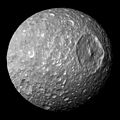Arkivo:Mimas Cassini.jpg

Grandeso de ica previdado: 600 x 600 pixels. Altra qualeso, en pixel-i: 240 x 240 pixels | 480 x 480 pixels | 768 x 768 pixels | 1 024 x 1 024 pixels | 1 800 x 1 800 pixels.
Arkivo originala (1 800 × 1 800 pixel-i, grandeso dil arkivo: 943 KB, MIME type: image/jpeg)
Historio dil arkivo
Kliktez sur la dato/horo por vidar arkivo quale ol aparis ye ta tempo.
| Dato/Horo | Miniaturo | Dimensioni | Uzero | Komento | |
|---|---|---|---|---|---|
| aktuala | 18:51, 23 jan. 2011 |  | 1 800 × 1 800 (943 KB) | WolfmanSF | {{Information |Description ={{en|1=In this view captured by NASA's Cassini spacecraft on its closest-ever flyby of Saturn's moon Mimas, large Herschel Crater dominates Mimas, making the moon look like the Death Star in the movie "Star Wars." Herschel C |
| 02:36, 19 may. 2010 |  | 2 000 × 2 000 (864 KB) | The High Fin Sperm Whale | {{Information |Description={{en|1=In this view captured by NASA's Cassini spacecraft on its closest-ever flyby of Saturn's moon Mimas, large Herschel Crater dominates Mimas, making the moon look like the Death Star in the movie "Star Wars." Herschel Crat |
Ligilo al imajo
Uzado en altra Wiki
La sequanta Wiki anke uzas ica arkivo:
- Uzado en af.wikipedia.org
- Uzado en am.wikipedia.org
- Uzado en ar.wikipedia.org
- Uzado en ary.wikipedia.org
- Uzado en arz.wikipedia.org
- Uzado en ast.wikipedia.org
- Uzado en azb.wikipedia.org
- Uzado en az.wikipedia.org
- Uzado en ba.wikipedia.org
- Uzado en be-tarask.wikipedia.org
- Uzado en be.wikipedia.org
- Uzado en bg.wikipedia.org
- Uzado en bn.wikipedia.org
- Uzado en bn.wikibooks.org
- Uzado en br.wikipedia.org
- Uzado en bs.wikipedia.org
- Uzado en ca.wikipedia.org
- Uzado en ckb.wikipedia.org
- Uzado en crh.wikipedia.org
- Uzado en cs.wikipedia.org
- Uzado en cv.wikipedia.org
- Uzado en cy.wikipedia.org
- Uzado en da.wikipedia.org
Videz altra uzadi por ica artiklo.




